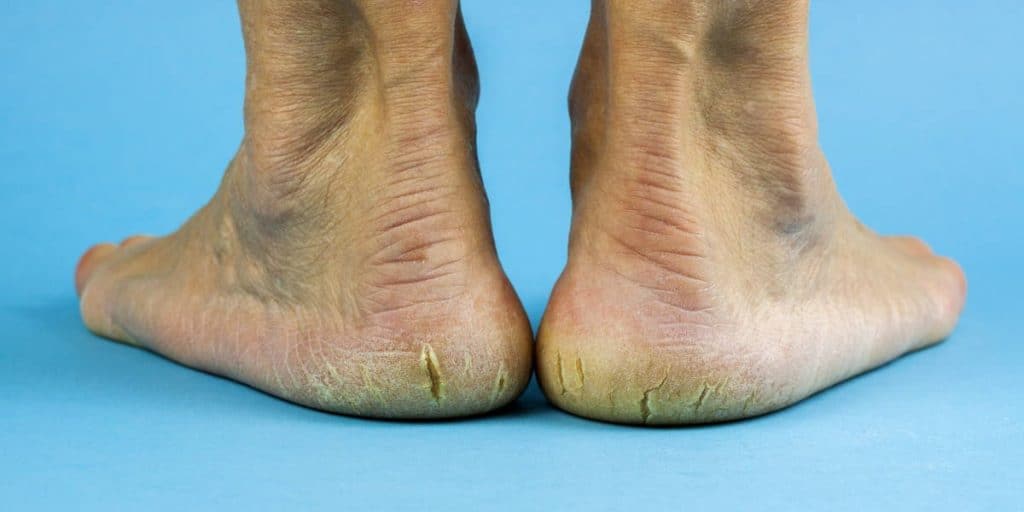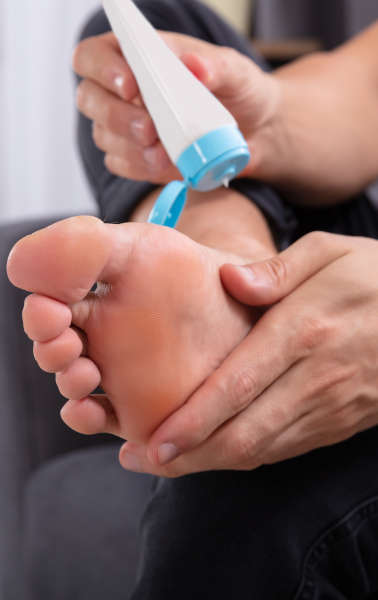Do I have cracked feet or dry skin?
Are cracked feet (heel fissures) and dry skin the same conditions? No, there is a difference. A big difference. Cracked heels cannot be remedied with a quick exfoliation of dead skin by a pumice stone or foot file.
Cracked feet manifest over time; you don’t awaken one morning with this condition. There are different stages of dryness that — if not cared for — lead to cracked feet. These symptoms/stages include:
1. Rough, dry heels
This is an early stage where the feet are very dry, but cracks have not appeared — and the best time to begin treatment.
2. Skin peeling
Skin begins to peel along the edges of the heels and is red and flaky. It’s a great time to begin treatment so cracks don’t begin to form.
3. Cracked skin
This stage manifests as dry, peeling feet with cracks on the bottom and along the edges of the heels.
4. Itchy feet
The feet are dry and cracked and the skin starts to tighten on the top of the feet, which causes itchiness.
5. Itchy rash
When itchy, cracked feet aren’t treated a rash may develop — and the itching continues.
6. Bleeding or discharge from cracks in the feet
When this condition remains untreated for long periods, the damage extends into deeper layers of skin. Untreated, severely cracked, dry feet can cause bleeding or discharge and are susceptible to infection.

What causes dry, cracked feet?
The skin on the bottom of the feet can peel and become dry and cracked due to any number of skin conditions. There are many causes of cracked feet and more than one cause can coexist at the same time.
Pressure
Any situation where you’re standing for long periods on a hard floor can cause cracked feet. If this happens frequently, investing in a heel cup may help better distribute your weight. Obesity or weight gain can also increase pressure on your feet.
Medication
Diuretics — medicines that rid the body of excess water and salt — and antihistamines — medicines that target allergic reactions and their symptoms — can cause dehydration. Dehydration can then lead to dry feet. Unfortunately, this side effect can go unnoticed and affect overall foot health.
Inappropriate footwear
Even the wrong choice of footwear can cause dry feet. Wearing shoes that are too tight can cause corns and calluses to form due to constant pressure and friction between your feet and shoes.
Open-back shoes and flip-flops provide minimal foot support, allowing the fat pads in the heel to expand sideways and increase pressure on the skin. Wearing open-back shoes and shoes without socks can also cause the skin to thicken as a means of protection.
Lack of moisture
Moisturizers hydrate and soften the skin — as well as help strengthen and protect the skin barrier. Inadequate skin care such as using harsh soap and not regularly moisturizing the feet can lead to dryness, thickening, and cracks.
The hot and humid environment inside a shoe may draw out the skin moisture and cause the feet to become thick, dry, and cracked.
Weather
Dry, cold weather in the winter can dry out your skin. Add in moisture-sucking heaters, wool socks, and boots, and more moisture is wicked from the skin, causing dry, cracked feet.
Vitamin and mineral deficiency
Dry, cracked heels can be a sign of vitamin deficiency. In wealthy countries like the United States, these cases are less common. Cracked heels are related to deficiencies in vitamins essential for skin health, such as vitamins C, B3, and E.
Vitamin C helps the skin retain moisture, and a deficiency can lead to dehydration — causing dry skin on the feet.
A zinc deficiency affects the body’s ability to metabolize fat and vitamin A — which are needed for healthy skin. Dry, malodorous feet are common symptoms of zinc deficiency.

Fungal infections
Fungal infections are caused by dermatophytes, a group of fungi that thrive in the warm, humid areas between the toes.
Athlete’s foot (a fungal infection on the feet) can cause itching, burning, and stinging sensations between the toes or on another part of the foot. In response to the infection, the skin may crack, peel, or blister.
Underlying medical conditions
Several underlying medical conditions can cause cracked feet.
Diabetes, hypothyroidism (under-active thyroid), eczema, psoriasis, and Sjögren’s syndrome (an autoimmune disease affecting the secretory glands) are all linked to heel fissures. Certain physical conditions — such as flat feet and heel spurs — can also make cracked heels more likely.
Pregnancy
Weight gain during pregnancy causes swollen feet as well as changes in posture and gait. The added pressure on the heels causes them to expand sideways and eventually crack if not moisturized.
Can I prevent dry feet?
Dry, cracked skin is more common in the winter months. But there are home remedies for dry feet that may prevent them from coming back. These are the suggested tips from the American Academy of Dermatology:
- Limit baths and showers to 5-10 minutes. Bathing or showering for too long dries out the skin and further irritates cracked heels. Be gentle when drying your skin with a towel.
- Clean the feet regularly by using a gentle, fragrance-free cleanser. Harsh soaps. Choose a gel or moisturizing soap instead. This will help your feet retain their natural oils.
- Apply a moisturizer twice a day. Choose an over-the-counter cream or lotion for dry feet that contains 10-25% urea, alpha hydroxy acid, or salicylic acid.
- It’s alright to wear sandals once in a while – well, it’s better than no shoes at all! But wearing them too frequently exposes your feet to the elements, causing them to dry out.
Apply it to the heels immediately after bathing while your skin is still damp, and whenever your heels are dry. Rubbing cream on dry feet helps lock in the moisture and is a great cracked feet remedy.
What is the best way to treat cracked heels?
- A foot soak for dry feet is very soothing. Soak your feet for about 10 minutes in soapy water. Then, gently rub your heels with a loofah or foot scrubber to help remove dead skin. This could be the best at-home remedy for dry, cracked feet.
- Before bed, apply Vaseline or petroleum jelly for dry feet. Consider wearing cotton socks to lock in the moisture and avoid getting grease on your bedding. Cotton socks are the best for dry, cracked feet.
- During the day, protect your heels by applying a liquid bandage over the cracks to create a protective barrier. This helps to reduce pain, speed healing, and prevent infection.
- Protect your feet from temperature extremes by wearing shoes when walking on the beach or hot pavement. Use sunscreen to protect exposed areas of the feet.
- When you have dry, cracked heels, wear the proper footwear. Avoid open-back shoes such as flip flops or slingbacks, shoes that are worn down, or shoes that don’t fit properly.
Sometimes cracked heels are caused by a medical condition. None of these steps is a substitute for informed medical advice. If you have severely dry, cracked heels and they do not improve, consult with a healthcare professional, like a board-certified podiatrist at University Foot & Ankle Institute.
Why choose University Foot and Ankle Institute for your foot and ankle care?
Whether you need to find proper footwear, treat an injury, or get advice on proper foot care, we’re here to help. Our podiatrists offer the most advanced podiatry care and the highest success rates in the nation. We are nationally recognized foot and ankle specialists and leaders in researching, diagnosing, and treating all foot and ankle conditions and common injuries.
Regular check ups with a skilled podiatrist can prevent serious foot problems by catching them early.
For a consultation please call (877) 736-6001 or make an appointment online now.
Our podiatrists take patients’ safety seriously. Our podiatry facility’s Covid-19 patient safety procedures exceed all the CDC’s coronavirus pandemic recommendations. Masks are always required in our institutes.
University Foot and Ankle Institute is conveniently located throughout Southern California and the Los Angeles area. Our foot doctors are available at locations in or near Santa Monica, Beverly Hills, West Los Angeles, Manhattan Beach, Northridge, Downtown Los Angeles, Westlake Village, Granada Hills, and Valencia.
- 15 Summer Foot Care Tips to Put Your Best Feet Forward - July 1, 2024
- If the Shoe Fits, Wear it… Especially for Kids Shoes! - September 4, 2023
- Is Barefoot Running Better? Or are you Running Toward Injury? - August 18, 2023